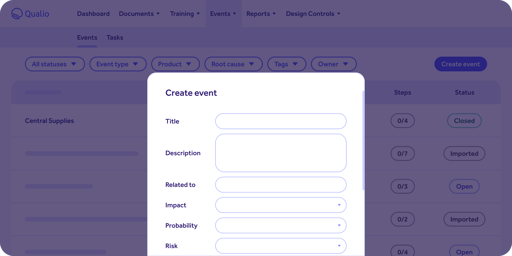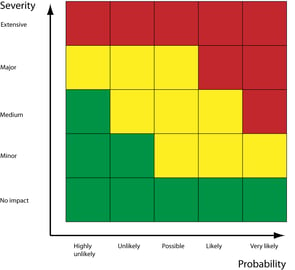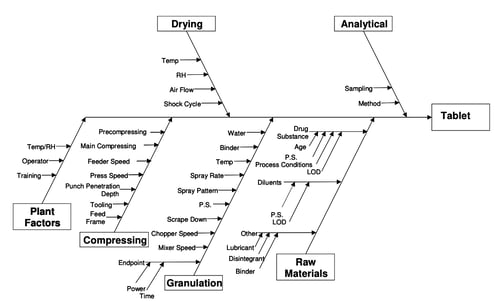Explaining CAPA management and the fundamentals of the CAPA quality process
The CAPA process is a critical component of modern quality management. And CAPA management, executed through robust and repeatable CAPA systems, is your organization's gateway to continuous quality improvement and optimization.
Getting an effective CAPA management system in place is absolutely essential if your business is to fix weaknesses, stamp out nonconformities, and hit its quality and compliance goals with consistency.
Here's everything you need to know about getting one in place.
Establishing a CAPA management system
A robust CAPA management system needs a coordinated web of activity in place.
Start by determining the key steps and procedures for your CAPA management.
How will issues be reported, investigated and resolved?
What are the roles, responsibilities and accountabilities of the individuals involved in the process?
And most significantly - what reporting mechanisms can you get in place?
You can only correct and prevent faults that you know about, so it's vital that your organization has a system in place for fast, easy reporting that kicks off a CAPA procedure quickly.
This could be having a designated person(s) on-site for people to report issues to, or better yet an electronic cloud-based form for instant submission from anywhere.

You should proactively look for things to fix, too, so a robust internal auditing program needs to be established. Build a repeatable audit cadence that lets you interrogate key areas of your business and spot weaknesses, bottlenecks, defects and faults to which CAPAs could be applied.
Consider, too, how to keep an ear open to customer complaints. Complaints and complaint investigations are a critical CAPA process, since they provide a source of external data to inform your improvement activities once your device or drug has hit the market.
RELATED READING: How to build a complaint management system
Effective CAPA systems need robust reporting, too.
Demonstrating 'improvement' by implementing CAPAs is a key regulatory requirement, cropping up in Clause 10 of Annex SL and, by extension, all modern ISO standards. If an auditor notes some non-conformances in a session, too, they'll expect to see documented evidence of how you've fixed them when they next visit.
A CAPA report is therefore a crucial ingredient to include in your CAPA management strategy, since it proves you've effectively treated a defect with clear application of CAPAs.
Lastly, you should have clear targets in mind for your CAPA steps to be applied to.
Where should your CAPAs be applied? There are 4 key areas you should prioritize for your CAPA activity:
1. Facilities & people: equipment, manufacturing environment, etc.
2. Organizational system: documents, SOPs, quality controls, etc.
3. Processes: steps, outputs, handoffs, etc.
4. Product: specifications, integrity, characteristics, etc.
These 4 areas will provide over 90% of your day-to-day operational risks, so it makes sense to apply the bulk of your corrective and preventive actions there.
Tips for CAPA procedures
- Make your CAPAs SMART - that is, specific, measurable, achievable, relevant and time-bound
- Clearly define roles and responsibilities for each stage of the CAPA process. Assign specific individuals or teams responsible for initiating, coordinating and tracking CAPA process steps to completion. This ensures accountability and ownership, encouraging timely resolution
- Get a mechanism in place for classifying the issues you're addressing. CAPA application should be sensible and risk-based - there's no point throwing all your resources at a minor defect when there's a major fire to fight
- Link your CAPAs to the severity, impact on quality, and potential risks of the issues they're addressing. This allows you to allocate resources tactically and address critical issues with the highest priority

- Make CAPA awareness an evolving part of your company culture with training. Not only should all individuals with CAPA responsibilities be adequately trained, your entire organization should understand the importance of actively reporting issues so they can be fixed.
Foster a culture of continuous improvement by encouraging employees to look for and report issues, and even to suggest improvement options themselves. Reward employees that take an active role here. Then ensure you regularly assess and enhance your CAPA strategy to adapt to your evolving organizational needs, such as when new products, processes and procedures are rolled out. - A final tip is around optimizing your CAPA management strategy. CAPA execution needs to be fast, accurate and controlled to have maximum impact and success. Manual or paper-based quality systems block visibility of quality issues and their root causes, making targeted CAPAs impossible.
One of our customers noted this very issue:
To accelerate and simplify your CAPA systems and the execution of your CAPA process steps, more and more organizations are turning to CAPA management software.
To provide effective safeguards against regulatory risk, CAPA management is usually included as core functionality within a modern electronic quality management system (eQMS).
At a high level, any effective electronic CAPA system must:
- Let you build a bespoke CAPA procedure, or multiple procedure types, which address your quality system requirements
- Facilitate data analysis to identify the sources of product quality issues
- Enable your organization to monitor trends for preventive action
- Integrate with other systems and QA processes to assure data quality
- Facilitate statistical analysis and formal failure investigations
- Allow your organization to validate the success of your preventive and corrective actions
LEARN MORE: CAPA management software: benefits and how to choose
With these tips in mind, let's take a look at the 5 fundamental steps of the CAPA quality process.
CAPA steps: the 5 fundamentals of the CAPA procedure
1. Detection
The problem identification and CAPA detection phase requires an appropriate documentation of the issue at hand. The description should be complete, including who, what, when, where, why, and how many.
Moreover, a risk analysis should be performed based on compliance risk. The results of the risk analysis should inform the CAPA timeline. In most cases, low-risk issues do not carry the same sense of urgency as high-risk issues.
2. Investigation & root cause determination
Next, your quality management team should commit to rapid CAPA analysis: that is, investigation of the issue and pinpointing of the root cause.
There are several methods for conducting root cause analysis, including:
- Brainstorming
- Flowcharting
- Fishbone diagrams
- Affinity diagrams
- Physics of failure

End-to-end traceability is crucial here. You should be able to track, and document, every root cause, change and applicable action step from the beginning to the end of your CAPA process.
RELATED READING: The 9 core elements of a quality management system
3. Proposed corrections
In this next phase, correction and containment should be completed as soon as possible to prevent further disruption.
Your organization should proactively review processes and procedures to identify broader issues. In the case of a product-related issue, field correction and/or recall may be required.
4. Implementation
At this point, long-term corrective and preventive actions work to resolve or eliminate the cause of nonconformity.
A corrective action is an action that eliminates the immediate cause of a nonconformity.
On the flipside, a preventive action eliminates the cause of potential future nonconformity.
5. Verification of effectiveness
Finally, you need to validate and verify your corrective and preventative actions' effectiveness. Once a CAPA investigation is complete, determine if nonconformities have been resolved. Did it work?
You should also determine if your corrective and preventive actions haven't created new areas of inconsistencies.
For instance, any changes to your production process that were made to address an issue should also be seen as a new source of potential problems. Monitor your actions closely for a set period of time to ensure no adverse, unintended consequences occur.
The 4 most common CAPA process problems to avoid
An effective CAPA process helps quality teams to identify areas of nonconformity and activate the appropriate countermeasures needed to prevent and resolve quality issues.
The U.S. Food and Drug Administration (FDA) places considerable emphasis on teams’ CAPA processes, and for good reason: an ineffective CAPA process places patients at risk.
As a result, teams must place patient health and safety at the forefront of all medical device or biopharmaceutical product quality and performance activities.
As you carve your path toward an effective CAPA management blueprint, here is a list of the major CAPA process problems that you must avoid at all costs.
1. Limited communication across departments
Poor cross-departmental communication can create massive gaps in your CAPA management system. Unfortunately, nonconformities often result in a snowball effect of cascading quality issues. Failure to communicate these issues only exacerbates the problem.
An effective CAPA process requires total alignment across the entire life sciences organization. When quality or compliance issues occur, team members must first identify the problems and then communicate the issue to all relevant stakeholders.
For the best results, encourage team members to communicate the following information:
- Where did the quality/compliance issue occur?
- Why did the quality/compliance issue occur?
- How might the organization respond to the quality/compliance issue?
If you’re looking for help, an electronic quality management system (eQMS) is an effective solution designed to improve cross-team collaboration and communication.
Most quality management systems come equipped with powerful reporting features purpose-built to help teams identify and respond to quality and compliance issues. Many teams rely on these types of quality management solutions as the organization’s single source of truth related to product quality, conformity, and more.
Is your team communicating as effectively as possible? If not, it might be time to reassess your processes, procedures, and tooling.
2. Being reactive instead of proactive
Many early-stage life science start-ups and scale-ups make the mistake of responding to quality and compliance issues retroactively.
However, a proactive approach to quality and compliance limits the number of unforeseen roadblocks that your team must hurdle during product design, development, and distribution.
When building a new medical device or biopharmaceutical product, it’s easy to rest on your laurels. But just when you think you’re finally ready to bring your new product to market, a quality issue thwarts the entire plan.
Unfortunately, these unexpected quality impediments prevent even the most forward-thinking life sciences companies from scaling successfully.
3. Poor root cause determination methods
Effective root cause determination methods serve as the backbone of CAPA systems. If you don’t get to the root cause of the issue, the problem is bound to recur.
To avoid running into the same issue over and over again, we recommend following the 6Ms of Production (manpower, method, machine, material, milieu, measurement) methodology when determining a root cause.
In short, this system encourages quality teams to develop a holistic approach to quality and compliance through the successful identification of systems, processes, and procedures used to deliver effective (or ineffective) manufacturing outcomes.
“Understanding how these factors impact the process and establishment of standards are key steps in strengthening production processes,” recommends KaufmanGlobal.
4. Overly complicated CAPA documentation
At the end of the day, your CAPA process steps should be perfectly in tune with your companies’ quality objectives. It should be well-documented — but not overly complicated or difficult to understand, either.
There are clear consequences for poorly defined CAPA processes. In fact, the FDA’s Office of Regulatory Affairs (ORA) routinely issues infractions related to the improper documentation, activation, and management of CAPA processes.
An eQMS is an invaluable solution that life sciences companies can use to properly document, distribute, and assign a CAPA procedure. In fact, many advanced quality systems even ship with automated reminders to facilitate improved issue response. Instantaneously assign quality professionals to compliance issues and activate daily or weekly notifications to keep them on the pulse of new or emerging quality issues.
Finding the best CAPA software for your company
Quality management issues have an immediate and significant impact on the success of your company. Failure to follow a CAPA procedure and identify the root cause of compliance issues can cause repeatable problems at unavoidable costs.
What's more, ineffective complaint handling can jeopardize brand reputation and customer relationships. As a result, purchasing control breakdowns may be linked to unreliable input quality, and speeding through the validation will produce unfavorable results.
This is precisely why an electronic quality management system is a necessity. By adopting the right solution during the start-up or scale-up phase, you can build your organization a strong baseline for effective CAPA management, supply chain management, and complaint handling.
Qualio is the first cloud-based electronic quality management system designed for growing life sciences organizations.
Schedule a demo today to learn more about how Qualio can help your organization embed a world-class digital CAPA process.
